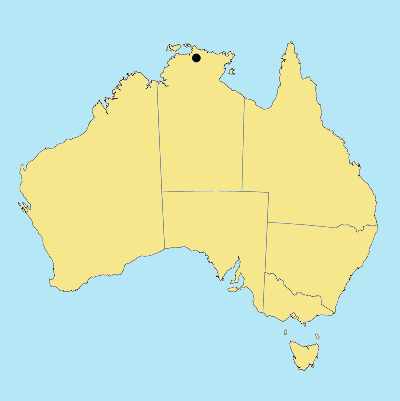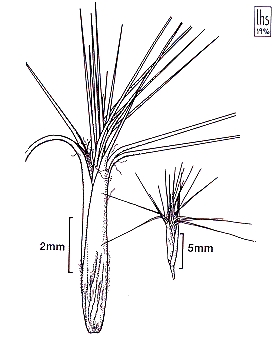Triodia aristiglumis Lazarides
Derivation
Triodia R.Br., Prodr. 182 (1810); from the Greek treis (three) and odous (tooth), referring to the 3-toothed or 3-lobed lemmas.
aristiglumis- from the Latin arista (bristle) and gluma (husk). With awned subtending glumes or lemmas.
Published in
Nuytsia 5: 278 (1984).
Common synonyms
Plectrachne aristiglumis Lazarides
Habit
Perennial, densely tufted. Culms erect, 60 cm tall, 3–4-noded. Mid-culm internodes smooth or scaberulous, glabrous or pilose. Leaf-sheaths without exudate, pilose or hirsute. Leaf-sheath auricles absent. Ligule a fringe of hairs, 0.8 mm long. Leaf-blades flexuous, conduplicate, 10–25 cm long, 2–3 mm wide, rigid, without exudate. Leaf-blade surface scabrous, hairless except near base. Leaf-blade apex pungent.
Inflorescence
Inflorescence compound, a panicle. Panicle open, lanceolate, 11–13 cm long, 3–4 cm wide. Primary panicle branches sparsely divided, 3 cm long.
Spikelets
Spikelets solitary. Pedicels 1–1.5 mm long. Fertile spikelets many flowered, comprising 5–6 fertile florets, with diminished florets at the apex, lanceolate, laterally compressed, 11–13 mm long, 2–3.3 mm wide, breaking up at maturity. Spikelets disarticulating below each fertile floret. Spikelet callus 0.3 mm long, bearded, base obtuse. Spikelet callus hairs white. Floret callus glabrous, obtuse.
Glumes
Glumes persistent, similar. Lower glume lanceolate, 7–8 mm long, 100% length of upper glume, membranous or cartilaginous, 3-nerved. Lower glume surface asperulous, glabrous or pilose, hairy at apex or below. Lower glume margins ciliate (above). Lower glume apex lobed, 2-fid, awned. Lower glume awn 6–12 mm long (laterals 2–3 mm). Upper glume lanceolate, 3–8 mm long, 120–130% of length of adjacent fertile lemma, membranous or cartilaginous, 3-nerved. Upper glume surface asperulous, glabrous or pilose, hairy at apex or below. Upper glume margins ciliate (above). Upper glume apex lobed, 2-fid, awned. Upper glume awn 8–9 mm long (laterals 3–4 mm).
Florets
Fertile lemma oblong, 6 mm long, cartilaginous, 3–9-nerved. Lemma surface scaberulous, pilose or villous, hairy in lines, with conspicuous apical hairs. Lemma margins ciliate. Lemma apex lobed, 2-fid, with lobes 7 mm long, 3-awned. Median (principal) awn from a sinus, reflexed or recurved at base of limb, 12 mm long overall. Lateral lemma awns present, arising on apex of lobes, 7 mm long, shorter than principal. Palea 5 mm long, membranous, 2-nerved. Palea keels scaberulous. Apical sterile florets 2–3, barren, rudimentary. Apical sterile lemmas 3-awned. Lodicules 2, fleshy. Anthers 3. Grain with adherent pericarp.
Continental Distribution:
Australasia.
Australian Distribution:
Northern Territory: Darwin & Gulf.
Classification. (GPWG 2001):
Chloridoideae: Triodieae
Notes
Native. Exposed ledges on sandstone escarpments; flowers February (summer).
Known only from a single locality


